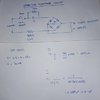Hi all,
I recently opened a led bulb which was not working and found that the leds were fine and the board was the one which had failed. It contains 10 white leds in series which individually needs about 5.5v to attain full brightness with a current draw of 30mA. So, I thought of making a dropper circuit using capacitor. I have few questions which I thought of clarifying before proceeding.

My first doubt is, will this circuit practically work ?
According to the above circuit, my capacitor will be dropping around 185v and 30mA of current will be flowing through it. So my second doubt is, do we have any 'power rating' that we must consider before using a X rated capacitor?
Even if the circuit is possible, to what extent is it going to affect the power factor?
Thanks in advance.
I recently opened a led bulb which was not working and found that the leds were fine and the board was the one which had failed. It contains 10 white leds in series which individually needs about 5.5v to attain full brightness with a current draw of 30mA. So, I thought of making a dropper circuit using capacitor. I have few questions which I thought of clarifying before proceeding.

My first doubt is, will this circuit practically work ?
According to the above circuit, my capacitor will be dropping around 185v and 30mA of current will be flowing through it. So my second doubt is, do we have any 'power rating' that we must consider before using a X rated capacitor?
Even if the circuit is possible, to what extent is it going to affect the power factor?
Thanks in advance.


